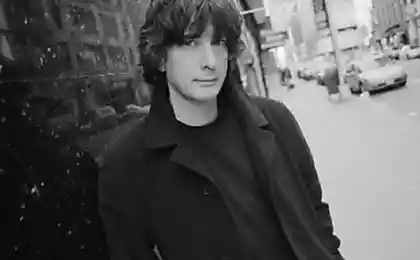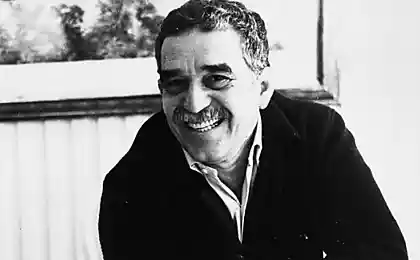290
5 famous heroines, which the authors of the books wrote off their favorite women


Love is the driving force behind creativity of incredible power. In support of this, we collected famous female images that famous writers created, inspired by their lovers.
A deep feeling instilled in these heroines charm and charm, making them so alive that we are in the world.Website We fall in love with them every time we read these books.
Mikhail Bulgakov and his Margarita

The main prototype of Margarita was Elena Sergeevna Shilovskaya (1893-1970), who became the third wife of Mikhail Bulgakov. Like Margarita, Elena before meeting with her "Master" was married and lived in prosperity - she was the wife of a major Soviet military commander Yevgeny Shilovsky. But Elena languished in this marriage, she did not need any money or position. And suddenly, in 1929, on a visit to mutual acquaintances, she finds herself at a table next to Bulgakov. They immediately fell in love with each other and very quickly realized that it was for life.
Elena about the first meetings with Bulgakov "The other day there will be another 32-year anniversary - the day of my acquaintance with Misha." It was on butter, some mutual acquaintances. <...> We were sitting next to each other, <...> I had some patches on my sleeve, <...> I told him to tie me up. And then he always assured me that there was magic here, that's where I tied him for life. <...> We agreed to go skiing the next day. And go. After skiing - the general "Blockade", after that - the acting club, where he played with Mayakovsky on a billiard. In short, we met every day and finally I prayed and said that I was not going anywhere, I want to sleep, and Misha did not call me today. I went to bed early, almost at 9:00. At night (it was about three, as it turned out later) Olenka, who did not approve of all this, of course woke me up: go, your Bulgakov calls you to the phone. <...> I came. “Dress up and go out on the porch,” Misha said mysteriously and, without explaining anything, only repeated these words. The moon shines terribly bright, Misha is white in her light standing at the porch. He took my hand and all my questions and laughter - puts his finger to his mouth and is silent. He leads across the street, leads to the Patriarch’s ponds, brings him to one tree and says, pointing to the bench: “Here they saw him for the first time.” Again, finger at mouth, silence again. Then came spring, followed by summer, I went to Essentuki for a month. I received letters from Misha, one had a dried rose, and instead of a photograph, only his eyes carved out of a card. (From letters from E. Bulgakova)

Elena went to her “Master” after a difficult breakup with her husband. In it, the writer found not only a beloved and faithful friend, but also his muse, assistant and biographer, guardian of the literary heritage.
Despite everything, despite the fact that there were moments of black, absolutely terrible, not anguish, but horror before a failed literary life, if you tell me that I had a tragic life, I will answer you: no! Not a second. It was the brightest life you could choose, the happiest.She wrote in the 1950s, after the death of Mikhail Bulgakov.
Marlene Dietrich as Joan Madu of The Arc de Triomphe Remark

The Arc de Triomphe is one of Erich Maria Remarque’s finest novels, and is particularly charmed by the excruciating romance of German surgeon Ravik with singer Joan Madu. The prototype of this controversial and beautiful heroine was the famous Marlene Dietrich, whom the writer loved for many years and with whom he lived in Paris before the outbreak of World War II.
Their love was both vivid and dramatic, and sometimes cruel. And everything that Ravik could reproach Joan - impermanence and coldness, the search for new feelings and love relationships - could say and Remarque his brilliant lover. He wrote her many passionate letters, which are published in a separate book. And it can be called another novel by the writer, perhaps the best.
“Honey, given by God. I think we were given each other at the right time. We waited so long for each other.," Remarque wrote to her.
The first meeting of Remarque and Dietrich, from the book of the daughter of the actress “My Mother Marlene” In her book My Mother Marlene (1992), the daughter of Hollywood star Maria Reva recounts how her mother described her first encounter with Remarque:
She was sitting with Sternberg in the Venetian Lido at lunch when a stranger approached their table.
- Mr. von Sternberg? Dear lady?
My mother didn’t like being spoken to by strangers at all, but she was fascinated by the man’s deep, expressive voice. She appreciated the delicate features of his face, the sensual mouth and eyes of the bird of prey, whose gaze softened as he bowed to her.
- Let me introduce myself. Erich Maria Remarque.
My mother extended her hand to him, which he politely kissed. Von Sternberg gestured to the waiter to bring another chair and suggested:
- Will you sit down with us?
- Thank you. If the gracious lady doesn't mind.
In awe of his impeccable manners, his mother smiled a little and nodded her head and asked him to sit down.
- You look too young to write one of the greatest books of our time, she said.
- Maybe I wrote it just to hear you say it in your magical voice. Clicking the gold lighter, he offered her a fire; she covered the flame tongue in his tanned hand with her thin white brushes, deepened the cigarette smoke, and with the tip of her tongue threw a crumb of tobacco from her lower lip. . .
Von Sternberg, the brilliant director, quietly retired. He recognized love at first sight.”
Francis Scott Fitzgerald and the fatal Nicole from The Night Is Tender

In a beautiful, as jazz, novel “The Night is Tender”, Fitzgerald described a personal drama, and the prototype of the main character Nicole Diver was his wife – a charming and stunned beauty Zelda. Frances and Zelda were the center of New York City social life, and reporters followed them everywhere, managing only to describe their antics - either ride on the roof of a taxi or appear naked in the theater. And in the book, Dick and Nicole are a brilliant and successful couple who lead a beautiful life, attract like a magnet, and fall in love at first sight.

Francis Scott Fitzgerald with his wife and daughter.
But in the life of the writer and in the book under this shining facade lurked sadness. Talented and beautiful Nicole Diver, like Zelda in real life, suffered from a mental disorder. Dick Diver was actually devastated and crushed by his wife's ailment, and eventually descended. But Nicole, having gained a foothold in an elusive reality, was healed. The life of the Fitzgeralds was sadder - he died of a heart attack in 1940, and she died in a fire in a clinic for the mentally ill 8 years later.
“Kissed, Bewitched” by Nikolai Zabolotsky

Nikolai Zabolotsky with his wife Catherine and daughter.
Nikolai Zabolotsky was famous for his complex character and contempt for women. Love lyrics were foreign to him. Despite this, the poet’s marriage was very successful. He married a classmate Ekaterina Klykova - slim, dark-eyed, short-spoken, who became a beautiful wife, mother and hostess. “The best of women,” wrote Eugene Schwartz.
Catherine gave her husband everything, helped him survive the imprisonment and exile, nursed after a heart attack, but she did not see much love or care. And suddenly, at the age of 48, she fell in love with the writer and famous heartthrob Vasily Grossman and left. “If she had swallowed the bus,” writes Nikolai, the son of Korney Chukovsky, “Zabolotsky would have been less surprised!”

Natalia Roskina.
Surprise was replaced by horror and confusion. Grief led him to 28-year-old Natalia Roskina - an unfamiliar lady editor who loved his poems. But this connection did not bring happiness to anyone. Zabolotsky was torn by feelings - he was fascinated by Natalia, but soon realized how much he loved his ex-wife.
Thus was born a cycle of lyrical poems “The Last Love”, dedicated to his wife Catherine and became one of the most piercing in Russian poetry. A special feature is “Recognition” – a real masterpiece. Although it is considered the only poem in the cycle that the poet dedicated to Natalia, it is believed that the images of both women merged here. Yes, and by the way, Catherine's wife soon returned to the poet - perhaps she first realized that he really loved her.
"Confession" Kissed, bewitched,
With the wind in the field once married,
You're all shackled,
My precious woman!
Not cheerful, not sad,
As if from the dark sky,
You and my wedding song,
And my star is crazy.
I will bend over your knees,
I'll embrace them with furious force,
And tears and poems.
I'll burn you, bitter, sweet.
Open my midnight face,
Let those heavy eyes enter,
In those black eyebrows of the east,
These are your hands, half naked.
What goes on doesn't go down.
What will not come true will be forgotten.
Why are you crying, beautiful?
Or do I just fancy it?
Nikolai Zabolotsky, 1957
John Tolkien and the Elven Princess Edith

On the left - a real photo of Edith, on the right - an unknown craftsman added colors and drew loose hair, like an elf. Although the creators of the film adaptation did not set such a goal (although, who knows), but Liv Tyler in The Lord of the Rings is very similar to her.
John Ronald Reuel Tolkien wrote off one of his main elven heroines from his wife, the beautiful Edith Bratt - short, black-haired, thin, light and musical. The romantic young man fell in love immediately, meeting her in early youth in a boarding house.
Once in the first years of married life, they walked in the forest, and Tolkien then enthusiastically wrote: “The sun pierced the branches of trees and golden high stems.” Edith's hair seemed black as a crow's wing, gray eyes shining. She sang wonderfully and danced in the sunny forest!
The wife’s dance inspired the writer to create a story about the love of the mortal warrior Beren and the elven princess Lutien Tinouviel, which became central to the book The Silmarillion. Beren first sees Luthien dancing in the woods of a hemlock. The story of Aragorn and Arwen in “Lord of the Rings” was a retelling of this piercing plot and in this form was the first to see the light.

On the way of the couple was a lot of difficulties: in his youth because of different faith, loved ones forbade John to see Edith (separation lasted three years), then there was a war, then overtook the test of glory.
But no problems and vicissitudes could darken the light of this youthful love, and the beautiful elf Edith-Luthien danced all her life in the forest glade hidden in the writer’s heart. "We always met (especially when we were alone) in the forest glade, and so many times, hand in hand, left, fleeing the shadow of imminent death. Until our last separation, John wrote to his son after the death of his beloved wife.

Tolkien said, “She was my Luthien, and she knew it.” John and Edith lived together for fifty-five years. His wife died first, but the writer did not live long. On their gravestone at Wolvercote Cemetery in Oscford, after their real names, the names "Beren" and "Luthian" can be seen.
Photo by New Line Cinema/Warner Bros.
See also.
10 real people who became the prototypes of our favorite movie heroes
10 famous characters, written off from real people
via www.adme.ru/tvorchestvo-pisateli/10-znamenityh-personazhej-spisannyh-s-realnyh-lyudej-1397415/
10 famous couples who are not afraid to give their relationship a second chance
Hilarious anecdote about Vovochka and meticulous teacher























